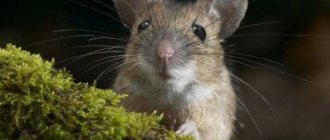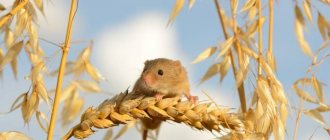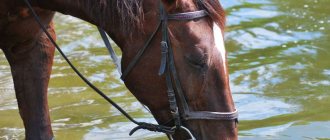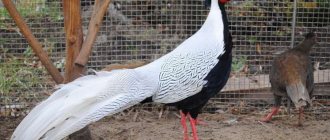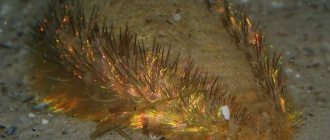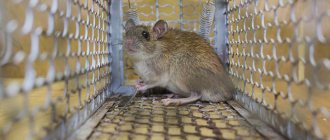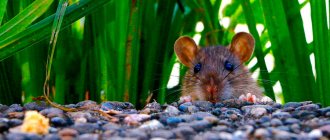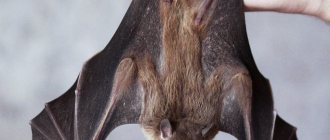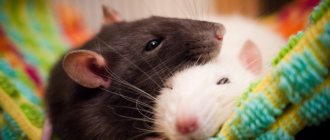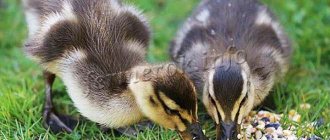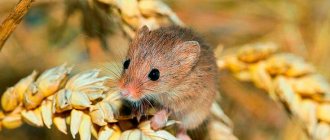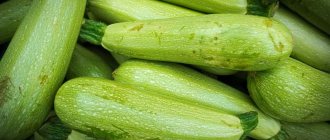It is traditionally believed that mice are omnivores. Many people know them as terrible gluttons who eat no less than 20% of all products that people produce.
For many centuries, poor mice were not loved for this. But today, good owners are wondering whether mice are really omnivorous, and how to feed the rodent correctly . Let's try to figure it out together.
When buying a decorative mouse, do not flatter yourself with the hope that you can feed it with scraps from your table.
Such a treat can cause unpleasant illnesses for your pet, since excess salt is not recommended for mice, and spices are completely contraindicated.
What to feed a rodent at home? There's no need to reinvent the wheel. The best option is balanced food for rodents, which is easy to find in any pet store today.
What do mice eat?
Animals belong to the order of rodents; the structure of the teeth and intestinal tract of the animal determines its diet. Mice are unpretentious and omnivorous; they can eat a variety of plant and animal foods. The peculiarity of the intestines does not allow them to fully absorb nutrients. Wild mice, constantly moving, require daily amounts of food comparable to their own weight.
Keeping a decorative mouse at home
Nutrition of mice in natural conditions
The favorite foods of rodents in the summer are grains and root vegetables. Mice cause significant damage to agriculture. Animals are voracious: they eat vegetables and fruits, seeds of trees (maple, beech) and plants (clover, fescue), and mushroom caps.
Rodents feed on small invertebrate animals. What do mice eat most often?
- grasshoppers;
- slugs;
- earthworms;
- spiders;
- crickets.
What do mice eat in winter in nature?
The animals create reserves for the cold season. They store food in secluded places underground, natural shelters, and in leaf litter. When there is a lack of food, mice gnaw at the roots of plants and eat the bark of trees. With the onset of frost, wild mice try to penetrate cellars and storages of vegetables and grain.
Interesting! Hungry rodents can eat wood and paper.
The damage caused by rodents
Knowing what a mouse eats, we can easily conclude why its presence in a house or field is unprofitable for humans. It is understandable that people do not want to share their food supplies with rodents. Therefore, they try in every possible way to get rid of the unwanted neighborhood when they find traces of them in storerooms and barns.
In addition to stealing food, the animals also leave their droppings everywhere, so it is no longer possible to use a bag of cereals in which pests were in charge. Rodents also damage the bark of fruit trees, which can lead to the death of seedlings. In Africa, for example, mice completely destroy coffee plantations, causing enormous damage to people.
Rodents carry many diseases. The most dangerous in this regard are not house mice, but field mice. Their feces and urine contain dangerous bacteria that can enter the human body and provoke an epidemic of pseudotuberculosis, hemorrhagic fever, tick-borne encephalitis and other deadly diseases.
Diet of mice in captivity
What do ferrets eat in the wild and at home - food list
When keeping an animal as a pet, it is necessary to provide the rodent with a balanced diet, which will ensure that the body receives proteins, fats and carbohydrates in sufficient quantities. A diet containing the necessary minerals and vitamins has a beneficial effect on the condition of the animal’s coat, bone tissue, teeth and claws.
What should you feed your mouse at home?
The easiest way is to purchase specialized feed in the store, available in the “economy” and “premium” classes. The basis of cheap feed is a mixture of wheat, oats, and millet. High-quality ready-made food has a balanced composition, contains valuable plant and animal proteins and fats, and essential microelements. Experts do not recommend feeding rodents exclusively with compound feed. They should be combined with natural products. Vegetables, fruits and herbs rich in fiber are especially important.
Ready-made food for rodents
What do mice eat when creating their own diet:
- various cereals, which it is advisable to give whole;
- root vegetables, vegetables, fruits;
- seeds, nuts; legumes;
- egg white, lard, cheese.
In the spring, lacking vitamins, the mouse willingly eats grass and green vegetables. The diet of young animals and pregnant females should contain more calories: proteins and fats necessary for growth and formation of the skeleton and internal organs.
The diet of a rodent is made up taking into account the following factors:
- daily nutrient requirements depending on the species or breed;
- physiological state (illness, pregnancy, postpartum period);
- pet's age;
- time of year (in summer mice feed more actively).
Important! It is unacceptable to feed your pet table scraps. Salt and spices can negatively affect the health of a rodent.
Reproduction
Mice are very fertile. They have no special marriage rituals. The male simply smells the female, finds her and mates. Sometimes there is rivalry and a fierce fight between males for the right to fertilize.
After a short pregnancy, the mouse gives birth to three to ten pups. They develop very quickly, and within three months they can bear offspring. Each female can give birth 3-4 times a year, so rodents reproduce very quickly. The most interesting thing is that some species live together in entire family clans, like people. In one burrow, young mice forming pairs successfully coexist with their parents.
In nature, predators regulate rodent populations. The wide distribution of animals throughout the territory of a certain area makes them easy prey for foxes, forest cats, birds of prey and snakes. If there is famine in the forest, then even wolves and coyotes do not disdain mice. In their natural habitat, animals usually live 7–9 months. At the same time, in captivity, mice can survive as long as 5 years. Therefore, they can become your life companions for years. If you are still in doubt whether to buy rodents for your home or not, then look at the photo of a field mouse. These cute animals will charm you with their innocence and cute appearance, and their rapid reproduction can even become your business and generate income.
What can you feed a mouse?
What do Djungarians eat - a list of healthy and harmful foods
In natural conditions, rodents move a lot in search of food, and they are not at risk of obesity. Keeping it at home leads to a sedentary lifestyle for the animal. Feeding should be carried out 2 times a day, the amount of food should be about 20% of the animal’s weight. The exception is the diet of pregnant females, who should be fed 4 times a day.
The mouse consumes a small amount of water; the liquid is formed in the animal’s body during the digestion of food. Despite this, a drinking bowl must be installed in the cage, where the water is replaced with fresh water every 2-3 days.
Cereals are the main food of rodents
What mice like - list of food items:
- Cereals should make up 30-40% of the diet. It is preferable to feed whole grain wheat, oats, millet, and barley.
- The bread is preferably black, in the form of crackers. White bread and buns contribute to the development of obesity.
- Root vegetables - carrots, beets - are offered to the animal every other day, potatoes - no more than 2 times a week.
- Mice love to eat seeds and nuts. However, they should be given once every 2-3 days; these are high-calorie foods.
- Legumes - beans, lentils are allowed to be added to the diet in small quantities 2-3 times a week.
- Fruits - apple, pear once every 3-4 days. In winter, dried fruits in small quantities are useful.
- Hay - contains a large amount of fiber, an essential food in winter to improve digestion. In spring, hay is replaced with sprouted wheat.
- In the summer-autumn period, crushed meadow and forest herbs are introduced into the diet: sweet clover, lupine, nettle, clover, plantain.
- Animal proteins - unsalted lard, chicken fillet, cottage cheese, egg white. Products are given every other day in small quantities.
- Vegetables - broccoli, cauliflower, cucumbers, zucchini - 2 times a week.
- Yeast, bone meal and chalk are periodically added to pet food as mineral supplements.
Many owners are interested in the question: can a mouse eat acorns? This is heavy food, but rodents need oak fruits in small quantities to wear down their teeth.
Acorns are good for teeth
On a note! It is useful for mice to give twigs of apple, hazel, and rowan. Animals need solid food. By chewing the bark, animals train their chewing apparatus. Lilac branches are poisonous to rodents.
What not to give to mice
Rodents love smoked meats, sausages, and fried meat products. This food contains a lot of fat, is harmful to the digestive tract of animals, and causes obesity. Foods that should not be fed to mice:
- chocolate, sweets;
- citrus;
- store-bought food for cats and dogs;
- cabbage, onions, tomatoes - cause bloating;
- herbs containing bitterness - wormwood, celandine;
- Milk can cause indigestion.
Spicy foods containing a lot of salt and spices significantly impair the functioning of the pet’s digestive tract, and in some cases can lead to its death.
Nutritional characteristics of mice depending on breed
What do rats eat at home and in the wild?
The diet of rodent species is similar, but there are some nuances in feeding different breeds of mice. Large animals need 7-15 g of food per day, small species need 5-10 g per day.
Japanese dwarf mouse
Japanese mouse
The size of a small decorative rodent does not exceed 4-6 cm. Animals are fed once a day, the amount of food is 1 tsp. The diet of the Japanese mouse is based on grains, vegetables, fruits, and greens. Animals love to chew on banana chips. For proper development of the skeletal system, be sure to add chalk to your food.
Wood mouse
The size of the animal is 7-10 cm. What wood mice like to eat: whole grain cereals, root vegetables, berries, fruits, pumpkin and sunflower seeds, nuts, mushrooms. In the summer, the animal willingly eats grass; in the winter, the animal is given hay.
Little mouse
The miniature animal measures 5-7 cm. The animal is fed 2 times a day, the volume of food should be 1-1.5 tsp. What mice like to eat: cereals, legumes, insects, pumpkin and flax seeds, egg whites.
Harvest mouse
An adult of this species reaches 10-13 cm. The rodent feeds on plant and animal foods. Mice should be given a variety of grains, roots, fruits, greens and regular vegetables. Pieces of chicken fillet, cottage cheese, and eggs are added to the diet. Pieces of bread are dried and given in the form of crackers.
Harvest mouse
Important! All breeds of mice consume at least 25 ml of water per day. The settled liquid should be kept in the drinking bowl around the clock.
Habitat
Mice live on all continents. Together with humans, they settled around the world and adapted to different climatic zones. Rodents feel great in the tropics, in the mountains, and in swamps. They are able to survive at staggering heights: 4 thousand meters is not the limit for these small creatures.
Mice usually settle near human settlements. This applies primarily to the brownie and Cairo varieties. After all, in cities and villages, at every step you can find what mice eat. Therefore, she is as comfortable as possible here. But if natural disasters occur - fires, floods or earthquakes, rodents are able to leave their usual habitat and migrate.
Those species that live in steppes or forests are poor swimmers. But marsh mice feel free on the water. Rodent houses come in three types:
- simple minks;
- complex burrows in the form of labyrinths;
- nests made of grass stems.
Mice lead a terrestrial lifestyle. They rarely climb trees, but they easily climb small bushes.
Why overeating and obesity are bad for mice
Rodents have a good appetite and are able to eat significantly more food than required. Overeating combined with a sedentary lifestyle often leads to obesity. Excess weight can be easily determined by the mouse's rounded abdomen and hard-to-palpate ribs.
Obesity negatively affects the health of the animal and leads to pathologies:
- diseases of the liver and bile ducts;
- disorders of the gastrointestinal tract;
- diseases of the heart and blood vessels, accompanied by shortness of breath;
- elevation of the diaphragm causes pulmonary failure;
- metabolic disorders lead to alopecia (baldness).
The pet becomes lethargic, drowsy, and deteriorating immunity makes the rodent defenseless to the manifestations of various infectious diseases. Obesity should be combated by observing food consumption standards, feeding regimens, and installing devices in cages that increase the animal’s mobility.
Attention! Despite the fact that mice love cheese very much, the product should be given rarely, in small quantities. Cheese is high in calories and causes fatty liver.
Cheese is a favorite treat
Owners of decorative rodents should know what to feed the mouse and correctly prepare a varied diet for the animal. Adequate nutrition of an animal is the key to its health and attractive appearance.
